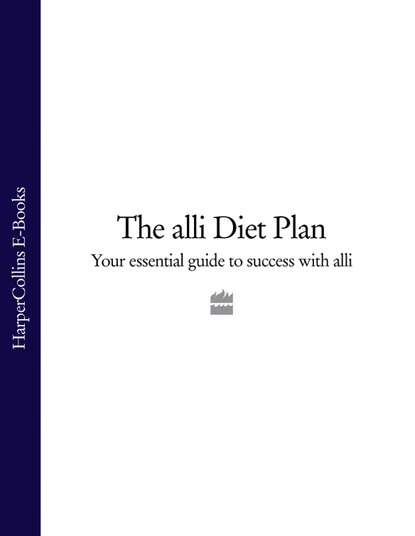По всем вопросам обращайтесь на: info@litportal.ru
(©) 2003-2024.
✖
The alli Diet Plan: Your Essential Guide to Success with alli
Автор
Год написания книги
2018
Настройки чтения
Размер шрифта
Высота строк
Поля
The Key to Weight-loss Success
Successful weight loss is about losing weight and keeping it off. To do this you need to understand how to eat and live healthily, not only while you are in your weight-loss phase, but beyond it, too. You also need to understand your own triggers to eating so that you can recognize when you are hungry, and when you are eating just because you are bored. More on this at the end of the chapter, but first some nutrition basics.
The Energy-balance Equation
Food and drink provide us with energy, which is measured in kilocalories, normally shortened to calories, or sometimes in joules and kilojoules. Our bodies use energy in a host of different ways: keeping our bodies ticking over – even digesting food needs calories; for maintenance and growth and the repair of our tissues and organs. We gain weight when we consume more energy (calories) than we use up, so in order to lose weight we need to consume fewer calories or use up more.
The healthiest way to lose weight is to use up more calories as well as consuming fewer. This is because:
• becoming more active is great for your health now and in the long term
• if you only cut down on food you run the risk of cutting out vital vitamins and minerals
• being active releases feel-good hormones, which help sustain your efforts and make you feel better
• you will improve your muscle tone
• studies have found that people who increase their activity as part of a diet maintain their weight-loss success for longer than those who only cut back on calories
• you are likely to lose weight faster.
Chapter 7 provides information on how to incorporate more activity into your daily life.
What Can I Eat?
This diet follows recommended nutrition principles for a healthier diet. That is, it encourages you to eat a balanced diet, eating foods from all the main food groups, control your calories through portion size and reduce fat intake, and also be more active.
This may not sound like rocket science. It isn’t. The diet is designed so that:
1. you achieve effective, gradual weight loss
2. you lose weight by eating ‘normal’, not ‘diet’ foods
3. you learn to take control of your eating by understanding more about foods and nutrition.
Alongside the diet you are encouraged to become more active and also to spend some time looking at the triggers that may make you eat when you are not hungry. Whole books have been written on the motivational side of eating and slimming, and it is not within the scope of this book to provide more than a thumbnail sketch with some practical hints and pointers to help you.
To start off with, you need to look at what a healthy, balanced diet really is so you can begin to make better choices from now on.
What Is a Healthy Balanced Diet?
A healthy, balanced diet contains the right amount and mix of nutrients and energy for your individual needs. Not too much and not too little – a sort of Goldilocks principle.
That sounds all fine and dandy, but who knows exactly how much energy you need or which particular vitamins and minerals you need the most? Few people do, and even then it will vary week by week. So we need a way of showing what this may be for an average healthy person.
There are different ways this can be done. Sometimes a pyramid of food and drink is used, or a basket depicting a range of food groups. The UK model is called the Eatwell Plate and represents the type and amount of different foods that should form part of a healthy diet.
The idea is to show you the relative proportion of food groups you need to eat as part of a healthy diet. There are five groups:
1. Fruit and vegetables
2. Bread, rice, potatoes, pasta and other starchy foods
3. Milk and dairy foods
4. Meat, fish, eggs, beans and other non-dairy sourced protein
5. Food and drink high in fat and/or sugar
If we all managed to eat these types of foods in suitable portions and were sufficiently active, we’d all have a healthy, balanced diet and be more likely to be a healthy weight. Unfortunately, most of us eat more of one group than another, especially the fatty and sugary foods group, and not enough of the fruit and vegetables group, so we end up with a poorly balanced diet, which can lead to overweight.
Let’s take a closer look at each food group and how it fits into your weight-loss diet.
Fruit and Vegetables
Fruit and vegetables are a really important part of any diet, as they provide a wide range of different vitamins, minerals and important plant substances. Each vegetable and fruit contains different amounts and types of these, so it is best to include as many different fruit and vegetables as you can. Eating a range of differently coloured fruit and vegetables each day is a good way to ensure you have a mixture of these essentials. For example, carrots, sweet potato, mango and pawpaw (orange) are rich in vitamin A, while vegetables such as spinach and cabbage (dark green) provide vitamin K. Tomatoes, strawberries and peppers (red) are particularly rich in vitamin C, as too are orange and yellow citrus fruits.
Fruit and vegetables contain a high proportion of water compared to the amount of calories they provide. This means they have a low energy density, which is good news for dieters, as along with their general bulkiness they are great for filling you up without adding lots of calories or fat (with the exception of avocados).
An often overlooked dietary essential is fibre, which is found in all plant foods. Fibre is the term used for many different compounds, and each has its own beneficial functions in the body. Keeping your bowel habits regular relies on insoluble fibre. Soluble fibre, meanwhile, increases feelings of fullness and also has a positive influence on your blood cholesterol levels.
You should be aiming for at least five portions of fruit and vegetables each day. If you are uncertain as to what a portion is, have a look at Chapter 9 (#litres_trial_promo) – but don’t forget that juice only counts once a day, and potatoes don’t count as vegetables. Also – to help you see that getting your five a day doesn’t have to be difficult – the menu plans in Chapter 3 all include at least five portions of fruit and vegetables.
Bread, Rice, Potatoes, Pasta and Other Starchy Foods
This category also includes breakfast cereals, oats and other grains. Starchy carbohydrates should be the most important source of calories in your diet. Starches are a type of carbohydrate that provide energy, and it is important to eat a starchy food at every meal, including some wholegrain versions as these give you additional fibre, minerals such as iron and calcium and B vitamins.
Starchy foods, especially those that are wholegrain, can be filling and are much less energy-dense than fat or oil. One gram of carbohydrate provides less than half the calories per gram compared to fats such as butter and oil.
You may have heard of foods with a high or low ‘GI’ or glycaemic index. Foods with a low GI help regulate your blood sugar so you don’t have surges of sugars in your blood after you’ve eaten, followed by a trough that leaves you feeling ravenous. These fluctuations are unhealthy and are thought to reduce the efficiency of the hormone insulin that controls your blood sugar. In the long term this can lead to diabetes. Foods with a high GI cause a sharp rise in your blood sugar, while those with a low GI cause a more gradual rise that is then prolonged. Having foods with a low GI helps you feel fuller for longer.
This diet encourages the use of lower-GI foods, and Chapter 9 provides nutrition and GI information on some commonly eaten foods. You may also find more information on the internet – and look for GI labels on some foods in supermarkets.
This is not a low-carbohydrate diet. Some people have great weight-loss results through cutting out carbohydrates, but for lifelong healthy eating this important food group provides essential nutrients and fibre.
Milk and Dairy Foods
Foods such as milk, yogurt and cheese (or the fortified soya alternatives) are essential for the calcium and vitamin B2 (riboflavin) they supply. Dairy products tend to contain a relatively high percentage of fat and saturated fat, but by choosing reduced-fat versions you will be able to meet your fat targets.
If you choose skimmed or semi-skimmed milk, reduced-fat yogurt and cheese, you will cut back on calories from fat and saturates but not on essential calcium or riboflavin.
You don’t have to use fat-free dairy products when on the diet if you follow the recipes and menu plans, as the diet allows for about 30 per cent of your calories to come from fat. This means you don’t lose out on vitamins A and D, which are important fat-soluble vitamins, found in milk and cheese.
Meat, Fish, Eggs, Beans and Other Non-dairy Sourced Proteins
This group also includes poultry, lentils, soya, tofu and vegetarian alternatives. We need surprisingly little of these foods – just a couple of small portions a day – and as some of these foods can be high in fat it is important to choose them carefully. Meat should be lean, with visible fat removed and skin trimmed from poultry. How these foods are cooked will also influence their fat content, so use fat-free or low-fat cooking methods such as grilling, baking, steaming, poaching and braising.
It is important to include plenty of fish in your diet, at least two portions a week. You can still include one portion of oily fish such as salmon or tuna in your diet by eating a small portion, making sure it fits within your fat target. Oily fish is one of the very few sources of dietary vitamin D, and it also contains omega-3 fatty acids, which have a wide range of health benefits. White fish is naturally low in fat and a great part of any weight-loss diet.











